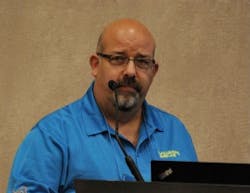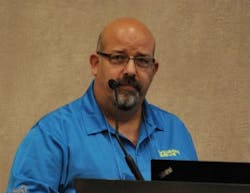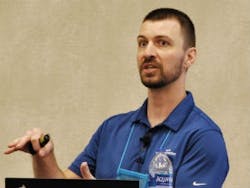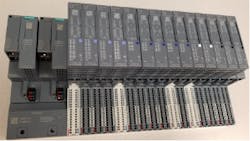MilliporeSigma modernizes DCS, paves way for future
"We desperately needed to come into the 21st century." MilliporeSigma's Andrew Sheppard on the company's urgent need to mondernize one of its aging—and increasingly obsolete—process control systems.
While MilliporeSigma’s Production III unit at its Sheboygan Falls, Wis., campus produces chemicals for the semiconductor industry that are on “the cutting edge of technology,” until recently the unit’s automation infrastructure was anything but, according to Senior Process Engineer Andrew Sheppard.
Indeed, before a recent modernization project, the unit had relied on a 1990s-era APACS+ control system, Intel Pentium-based industrial PCs running Windows 95, and obsolete I/O modules whose dwindling support had stretched replacement delivery times to 12 months or longer.
“We desperately needed to come into the 21st century,” Sheppard said.
At the Siemens Automation Summit 2019 in Denver, Colo., Sheppard, together with Nathan Nutter, controls engineer II with integration firm Trident Automation, discussed the design considerations that went into the unit’s recent control system modernization that now heavily relies on the latest control, communications and I/O technologies from Siemens Digital Industries, notably the SIMATIC PCS 7 Version 9 DCS.
“We’ve gone from the oldest control system onsite to the latest,” Sheppard said.
Easy transition, future sustainability
But before laying claim to bragging rights, Sheppard outlined the key parameters by which the project was to be judged successful. “We needed to make the change-over with minimum downtime, and since a plant expansion was in the works, we needed the solution to be scalable,” Sheppard said. Because there wasn’t an abundance of controls expertise on site, remote support capabilities were also high on the requirements list.
And while moving to a current generation control platform would certainly help to reduce ongoing system maintenance costs and effort, the plant also wanted to provide a familiar environment for plant operators that would allow them to take advantage of new “bells and whistles” that could be rolled out more gradually, Nutter added.
“To facilitate system maintenance, we wanted to standardize the hardware as well as the underlying code where possible, too,” Nutter said. Cybersecurity was a concern, as was selecting hardware platform and protocols that would keep the system viable well into the future.
"There's no single point of failure, as each redundant CPU has its own path to the I/O." High availability was just one of the reasons that MilliporeSigma went with Siemens' SIMATIC PCS 7 DCS, Trident Automation's Nathan Nutter said.
The plan comes together
Because system obsolescence reached all the way to the input/output level, the old APACS+ I/O was eliminated in favor of Siemens’ current generation ET200SP HA I/O modules. This platform is flexible, compact, easy-to-use and quick-to-wire, as well providing high availability through redundant components and network interfaces, Nutter explained. It also allowed MilliporeSigma to eliminate the outdated HART Fieldbus Modules (HFMs) and Profibus Fieldbus Modules (PFMs) that were needed with the older system.
The ET200SO HA modules are hot-swappable; communicate via the industry-standard, Ethernet-based PROFINET protocol; and can be installed in hazardous areas up to Zone 2. The need to replace obsolete, intrinsically safe I/O in Zone 1 areas was addressed with the use of ET200SP HA modules in conjunction with standard intrinsic safety barriers. This eliminated the need for yet another I/O network protocol and consolidated spare parts requirements by leveraging I/O and IS barrier designs already in use, Nutter said.
The project team took a high-availability approach that includes redundant SIMATIC S7-410 controllers, power supplies and SCALANCE network switches in each of the distributed control panels. “There’s no single point of failure, as each redundant CPU has its own path to the I/O,” Nutter said.
From a networking perspective, the unit’s new automation and information architecture includes a number of features that ease network management tasks while ensuring cybersecure communications. The SCALANCE switches themselves can work with virtual local area networks (VLANs) and support network access protection in compliance with the IEEE 802.1x authentication standard to enable secure remote access and integration. The switches also feature port mirroring, which helps to reduce network congestion, Nutter said. A service bridge and graphical topology editor also ease network management tasks across the system.
At the foundation of MilliporeSigma's new SIMATIC PCS 7 DCS are Siemens ET200SP HA I/O modules: a flexible, compact, easy-to-use and quick-to-wire platform that offers high availability through redundant components and network interfaces.
As part of the modernization effort, MilliporeSigma also requested the installation of three new industrial PCs in the plant’s Class I, Division 1 hazardous areas. These purged systems, which included Siemens IPCs, provide convenient visibility into the PCS 7 system and minimize the need for operators to trek back and forth between hazardous and non-hazardous areas. “The operators are more productive and happier, even if their pedometers aren’t,” Nutter joked.
Successful execution of the modernization project also relied on close, constant communication between Trident Automation and MilliporeSigma teams. “We set up a virtual environment so the operators could familiarize themselves with the new system prior to install,” Nutter said. “This SIMIT simulation environment was also used for testing and virtual commissioning to ensure that start-up of the new system would go smoothly.”
The end result
MilliporeSigma set out to modernize its control systems primarily because the older system had become unreliable and increasingly expensive to maintain in working order. They selected Siemens and Trident Automation because the two suppliers demonstrated a keen understanding of their needs—and promised to deliver at a competitive cost.
“Upgrading to PCS 7 meant we could get components off the shelf and not off eBay,” Sheppard said. “I couldn’t be happier.”
While the project team certainly succeeded based on the above criteria, today Andrew Sheppard also gauges the success of the project on how easy the transition has been for MilliporeSigma’s operations staff. “Operators appreciate continuity in the HMI screens compared to before,” he said.
Visualization is faster and actions are confirmed more quickly, plus it’s easier to troubleshoot, Nutter added. “Now the company is looking into adding automation that wouldn't have been considered in the older system.”
About the Author
Keith Larson
Group Publisher
Keith Larson is group publisher responsible for Endeavor Business Media's Industrial Processing group, including Automation World, Chemical Processing, Control, Control Design, Food Processing, Pharma Manufacturing, Plastics Machinery & Manufacturing, Processing and The Journal.

Leaders relevant to this article:




